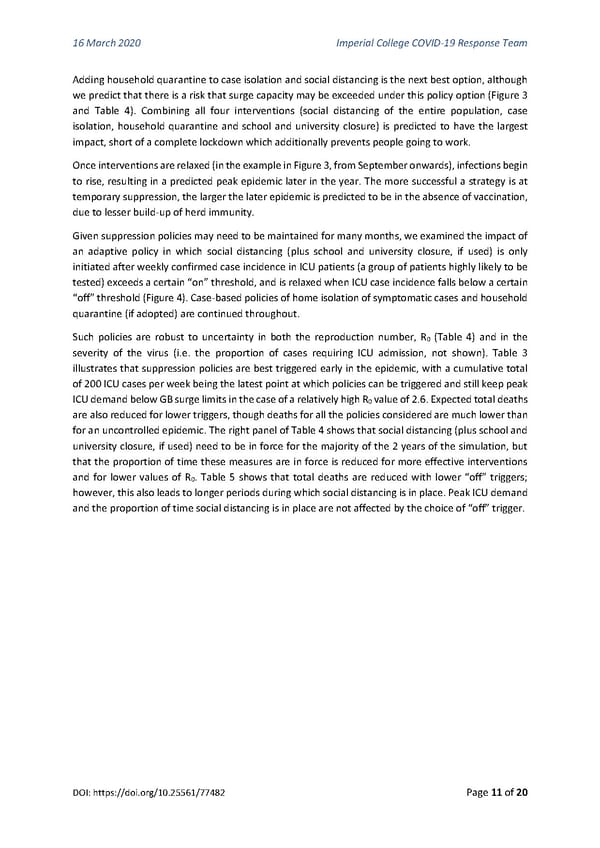16 March 2020 Imperial College COVID-19 Response Team Adding household quarantine to case isolation and social distancing is the next best option, although we predict that there is a risk that surge capacity may be exceeded under this policy option (Figure 3 and Table 4). Combining all four interventions (social distancing of the entire population, case isolation, household quarantine and school and university closure) is predicted to have the largest impact, short of a complete lockdown which additionally prevents people going to work. Once interventions are relaxed (in the example in Figure 3, from September onwards), infections begin to rise, resulting in a predicted peak epidemic later in the year. The more successful a strategy is at temporary suppression, the larger the later epidemic is predicted to be in the absence of vaccination, due to lesser build-up of herd immunity. Given suppression policies may need to be maintained for many months, we examined the impact of an adaptive policy in which social distancing (plus school and university closure, if used) is only initiated after weekly confirmed case incidence in ICU patients (a group of patients highly likely to be tested) exceeds a certain “on” threshold, and is relaxed when ICU case incidence falls below a certain “off” threshold (Figure 4). Case-based policies of home isolation of symptomatic cases and household quarantine (if adopted) are continued throughout. Such policies are robust to uncertainty in both the reproduction number, R (Table 4) and in the 0 severity of the virus (i.e. the proportion of cases requiring ICU admission, not shown). Table 3 illustrates that suppression policies are best triggered early in the epidemic, with a cumulative total of 200 ICU cases per week being the latest point at which policies can be triggered and still keep peak ICU demand below GB surge limits in the case of a relatively high R value of 2.6. Expected total deaths 0 are also reduced for lower triggers, though deaths for all the policies considered are much lower than for an uncontrolled epidemic. The right panel of Table 4 shows that social distancing (plus school and university closure, if used) need to be in force for the majority of the 2 years of the simulation, but that the proportion of time these measures are in force is reduced for more effective interventions and for lower values of R . Table 5 shows that total deaths are reduced with lower “off” triggers; 0 however, this also leads to longer periods during which social distancing is in place. Peak ICU demand and the proportion of time social distancing is in place are not affected by the choice of “off” trigger. DOI: https://doi.org/10.25561/77482 Page 11 of 20
 Non-Pharmaceutical Interventions to reduce COVID-19 mortality and healthcare demand Page 10 Page 12
Non-Pharmaceutical Interventions to reduce COVID-19 mortality and healthcare demand Page 10 Page 12